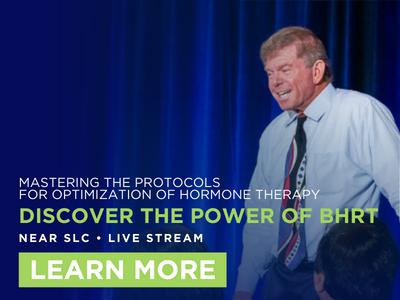
What Healthcare Providers Need to Know About The Women’s Health Initiative (WHI)

What Healthcare Providers Need to Know About The Women’s Health Initiative (WHI)
If you’ve taken any of Worldlink Medical’s CME courses with Dr. Neal Rouzier, you’ve learned about the hornet’s nest of controversy over prescribing hormones to women in menopause that’s been stirred up over the past two decades. You may be familiar with the landmark 2002 study, The Women’s Health Initiative but you may be a little confused on the results and actual implications of the study results vs what the media reports.
That study had a major impact on the prescribing of hormones and, even more dramatically, on women’s willingness to take hormone replacement therapy. The WHI was stopped early, in 2002. Preliminary results were initially announced through press release and press conferences, rather than through articles in peer-reviewed scientific journals.
The most alarming statistic to come from the WHI was the contention that women taking HRT had a 26% increased risk of breast cancer over women who weren’t on hormones. Headlines in the lay media took hold of that terrifying number and ran with it, creating mistrust and fear in women (and healthcare providers) that has reverberated since.1
There it was . . . the last word on HRT. “HORMONES CAUSE BREAST CANCER” (according to the WHI)
Careful evaluation of the WHI leads thoughtful practitioners to question this statement, which has become conventional wisdom in the past couple of decades. The reality is much less frightening, if equally dramatic.
The Conclusions of The WHI Are Completely Wrong
The data in the WHI does not show HRT to increase risks for invasive breast cancer.
We need to understand several key points regarding the WHI in order to untangle the truth from what the primary investigators have reported.
- First, the patients chosen for the study were not the same as the patients most likely to be prescribed hormone replacement therapy.
- Second, many of these patients exhibited signs and symptoms of some of the diseases the study concluded were caused by hormones, even before the study began.
- Third, the study used the “Gold Standard” of hormone replacement therapy at the time. This combination of hormones has been repeatedly shown by subsequent studies to be inferior to other hormone combinations in both effectiveness at relieving symptoms and in safety.
- Fourth, and most importantly, the risks for disease that were purportedly due to HRT were wildly overstated and, with few exceptions, not statistically significant.
Patients Treated in the WHI
Let’s take a look into the patient population in the WHI.
The women recruited to complete the study were, on average, 63 years old. That’s about 12 years past the average age of menopause, 51. That means that very few of these patients were experiencing the symptoms that HRT would be prescribed for in the first place. The researchers specifically excluded patients who had moderate to severe hot flashes, on the grounds that these patients would easily see through double blinding and guess whether they were on the hormone treatment or placebo.
Because these patients were significantly older than women entering menopause, they also had multiple health issues that are associated with advancing age. About 35% of them were overweight. 34% were obese. 36% were hypertensive. Nearly 50% reported a history of smoking.2 The health status and age of the patients may have contributed to any untoward effects of the treatment provided in the study.
The poor health of a significant portion of WHI participants is ironic, considering the title of the final report, which refers to “Healthy Postmenopausal Women.”
Hormones Used in The WHI
The specific hormones used in the Women’s Health Initiative were widely accepted as the standard of care at the time of the study.
The estrogen used in the WHI was conjugated equine estrogens. This estrogen combination was used in menopausal women since it was developed in the early 1940s by Wyeth-Ayerst. The specific estrogens in conjugated equine estrogens are somewhat of a mystery. Wyeth (now Pfizer) has been able to keep the exact composition a ‘trade secret” for decades. The pharma giant successfully blocked a “citizen’s petition” to the FDA to clarify its ingredients in 1996.3,4. There are at least 10 distinct conjugated estrogens in the horse urine preparation.5. Several of these estrogens are not found in human females and their safety and efficacy as individual drugs has never been studied. It’s obvious that a mixture of hormones derived from horse urine would likely be contaminated with an untold number of by-products, hormones and kidney-metabolized waste.
Wyeth also supplied the progestin given to these patients, medroxyprogesterone, a synthetic version of progesterone chosen for its potency. Medroxyprogesterone is chemically similar to progesterone except that it has an alpha-hydroxy group at position 17 and a methyl group at position 6.6 These slight chemical changes make medroxyprogesterone 10 to 20 times more potent than progesterone and have the potential to completely change its safety profile. Medroxyprogesterone has been used since the 1960s to counteract the endometrial hyperplasia caused by uterine exposure to estrogens.
In the past all estrogens were widely considered to have the same risks and benefits. All progestins were similarly considered equivalent. The evidence accumulated after nearly 2 decades since the study points to major differences between specific hormones, both in safety and effectiveness.7,8,9,10,11,12
Statistical Significance of Breast Cancer Risk Increase From HRT
A single sentence, or more precisely, a single word, from the Women’s Health Initiative findings, telegraphs what’s wrong with the study.
“The 26% increase (38 vs 30 per 10,000 person-years) observed in the estrogen plus progestin group almost reached nominal statistical significance and, as noted herein, the weighted test statistic used for monitoring was highly significant.”13(emphasis added)
This sentence clearly states that the “26% increase” in breast cancer incidence seen in the WHI did not reach statistical significance. It almost did.
“THE 26% INCREASE (38 VS 30 PER 10,000 PERSON-YEARS) OBSERVED IN THE ESTROGEN PLUS PROGESTIN GROUP ALMOST REACH NOMINAR STATISTICAL SIGNIFICANCE…..” WHI WRITING GROUP
Study investigators chose to emphasize relative risk in their conclusions, highlighting a “26% increase” in risk that appears to be dramatic and frightening. The reality is that relative risk is just that, relative. The absolute risk is also found in the same sentence. “(38 vs. 30 per 10,000 person-years) . . .” The absolute risk of breast cancer was increased in the estrogen+progestin group by 8 breast cancer cases out of 10,000 women. That’s an absolute increase of 0.08%, much less dramatic sounding than the 26% emphasized in the study conclusions.
Again, this 26% increase in relative risk was not statistically significant, according to the researchers who wrote the study results.
That means there is no valid statistical argument from this study that conjugated equine estrogen plus medroxyprogesterone increases the risk for breast cancer and any increase would have to be considered coincidental. The investigators also concluded that there was an absolute decrease in breast cancer incidence in women taking only conjugated equine estrogens. Multiple evaluations of the WHI data since the original publication have confirmed the weakness of the association between HRT and breast cancer risk.
A Fearful Message With Devastating Results
This post is not intended as a comprehensive review of every aspect of the Women’s Health Initiative study. Many qualified scientists have rightly criticized the study and the outrageous conclusions drawn by investigators.14 Others have taken these conclusions at face value, disseminating a message that hormone replacement is something to fear. That message has had devastating results on millions of women denied safe, effective treatment for life-changing menopause symptoms over the past two decades.15,16
Learn More
If you’d like to understand more about the nuanced interpretation of The Women’s Health Initiative, consider attending Part I: Discover the Power of BHRT – the first course in the Mastering the Protocols for Optimization of Hormone Replacement Therapy. In this AMA accredited CME course, Dr. Neal Rouzier goes into much greater detail about the WHI and the conclusions reached by researchers. Attendees will discover the controversies and the political intrigue that has cast a shadow over hormone replacement for the past two decades. Attendees will also discover the benefits of hormone optimization in reducing long-term health risks, including breast cancer, as proven by hundreds of valid studies showing actual statistical significance.
References:
-
- Haas JS, Geller B, Miglioretti DL, et al. Changes in newspaper coverage about hormone therapy with the release of new medical evidence. J Gen Intern Med. 2006;21(4):304–309. doi:10.1111/j.1525-1497.2006.00342.x
- Langer RD, White E, Lewis CE, Kotchen JM, Hendrix SL, Trevisan M. The Women’s Health Initiative Observational Study: Baseline Characteristics of Participants and Reliability of Baseline Measures. Ann Epidemiol 2003;13:S107–S121.
- Department of Health and Human Services Office of Inspector General — AUDIT “Review of the Food and Drug Administration’s Handling of Issues Related to Conjugated Estrogens,” (A-15-96-50002) May 16, 1997
- Federal Register / Vol. 61, No. 217 / Thursday, November 7, 1996 / Notices
- Bhavnani BR. Pharmacokinetics and pharmacodynamics of conjugated equine estrogens: chemistry and metabolism. Proc Soc Exp Biol Med. 1998;217(1):6–16. doi:10.3181/00379727-217-44199
- Compound summary: Medroxyprogesterone | C22H32O3 PubChem
- Fournier A, Berrino F, Clavel-Chapelon F. Unequal risks for breast cancer associated with different hormone replacement therapies: results from the E3N cohort study [published correction appears in Breast Cancer Res Treat. 2008 Jan;107(2):307-8]. Breast Cancer Res Treat. 2008;107(1):103–111. doi:10.1007/s10549-007-9523-x
- Regidor PA. Progesterone in Peri- and Postmenopause: A Review. Geburtshilfe Frauenheilkd. 2014;74(11):995–1002. doi:10.1055/s-0034-1383297
- Asi N, Mohammed K, Haydour Q, et al. Progesterone vs. synthetic progestins and the risk of breast cancer: a systematic review and meta-analysis. Syst Rev. 2016;5(1):121. Published 2016 Jul 26. doi:10.1186/s13643-016-0294-5
- Mirkin S, Amadioa JM, Bernicka BA, Pickarb JH, Archer DF 17-Estradiol and natural progesterone for menopausal hormonetherapy: REPLENISH phase 3 study design of a combination capsuleand evidence review Maturitas S0378-5122(15) 00314-X/dx.doi.org/10.1016 j.maturitas.2015.02.266
- Miller VM, Naftolin F, Asthana S, et al. The Kronos Early Estrogen Prevention Study (KEEPS): what have we learned?. Menopause. 2019;26(9):1071–1084. doi:10.1097/GME.0000000000001326
- Palacios S, Mejía A. Progestogen safety and tolerance in hormonal replacement therapy. Expert Opin Drug Saf. 2016;15(11):1515–1525. doi:10.1080/14740338.2016.1223041
- Writing Group for the Women’s Health Initiative Investigators. Risks and Benefits of Estrogen Plus Progestin in Healthy Postmenopausal Women: Principal Results From the Women’s Health Initiative Randomized Controlled Trial. JAMA. 2002;288(3):321–333. doi:10.1001/jama.288.3.321
- Critiques of The Women’s Health Initiative PubMed Bibliography
- Millions of women are missing out on hormone replacement therapy The Economist December 12,2019
- Sarrel PM, Njike VY, Vinante V, Katz DL. The mortality toll of estrogen avoidance: an analysis of excess deaths among hysterectomized women aged 50 to 59 years. Am J Public Health. 2013;103(9):1583–1588. doi:10.2105/AJPH.2013.301295
